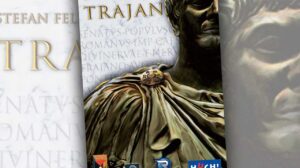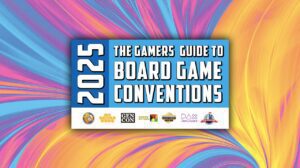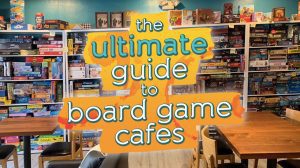Hello and welcome to ‘Focused on Feld’. In this series of reviews, I am working my way through Stefan Feld’s entire catalogue. Over the years, I have hunted down and collected every title he has ever put out. Needless to say, I’m a fan of his work. I’m such a fan, in fact, that when I noticed there were no active Stefan Feld fan groups on Facebook, I created one of my own.
Today we’re going to talk about 2024’s Nassau, his 39th game.
Game #7 in the Stefan Feld City Collection (SFCC), Nassau is an evolution of Feld’s 2006 game, Rum & Pirates. I call it an ‘evolution’ as Nassau borrows the core mechanic of Rum & Pirates and then adds a lot more game on top of it rather than just tweaking a thing here and there. Thus far, this is the only City Collection game that reimplements an earlier design but doesn’t change the setting. Rum & Pirates takes place in the pirate’s hideout of some unnamed city on an island somewhere in the Caribbean. Nassau gives that city a name. And, whereas Rum & Pirates focused squarely on the activities of the titular pirates during their shore leave, Nassau takes things a step further, letting the players experience the pirates’ lives both on, and off, the ship.
Here’s how it works…
First, the Familiar
The city of Nassau is composed of nine District tiles arranged in a random 3×3 grid. Each of these tiles features clusters of road segments that come together at various intersections. Each of these intersections features an icon that describes an action. Somewhere amidst these intersections is one containing the pirate captain. On their turns, players will be placing pirate figures from their personal supply on road segments (one per segment, starting from the pirate captain’s location) until they reach another intersection. Then, the pirate captain moves to the new intersection, and the player carries out the associated action. After carrying out their action, a player may choose to pass, or they may spend a coin to perform another action.
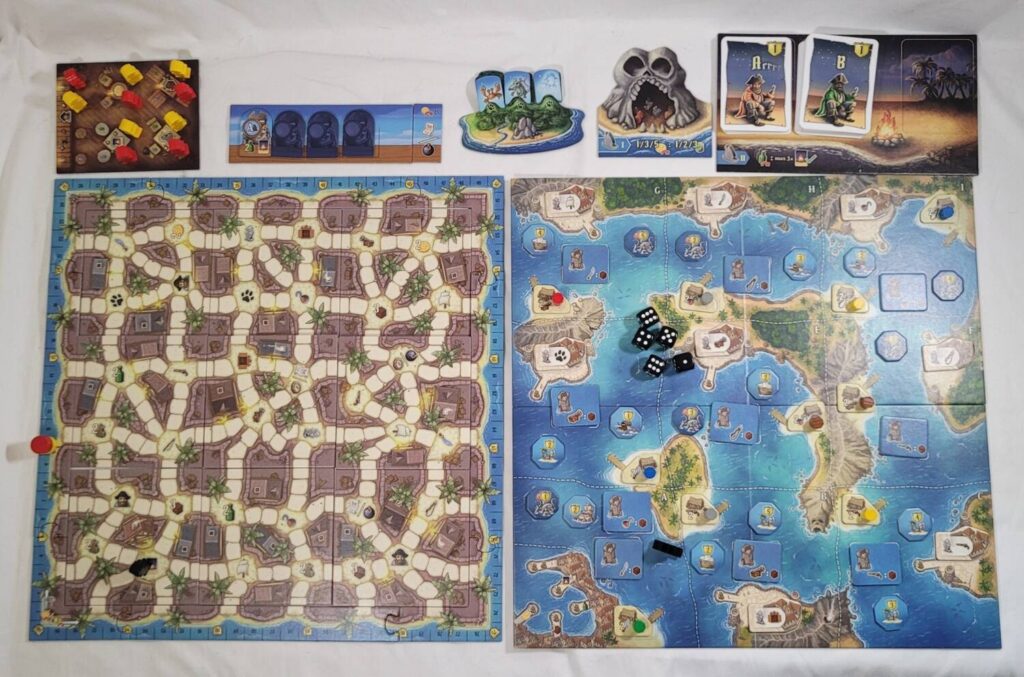
This series of actions constitutes Phase 1 of a game round, the Nassau City phase. If you’ve ever played Rum & Pirates, no doubt the paragraph above will seem familiar. The aspects of how the tiles are arranged and how the Red Corsair moves in Rum & Pirates are the only similarities between the two titles. Even the actions performed at the intersections are different.
This is just to say, if you enjoy Rum & Pirates and you’re hoping to enjoy that experience in a new format with a slight modification here and there to make things more streamlined and just a little better (like Hamburg does for Bruges, for instance) then just be aware: that doesn’t describe Nassau. It’s a vastly different experience with many brand new elements. Elements such as…
Your Ship and Your Hideout
Each player begins the game with their own Ship board as well as a randomly distributed Hideout. During Phase 1, players have the opportunity to move the pirate captain around the city of Nassau to collect weapons, additional sails, doubloons, rum, bombs, compasses, extra pirate figures, extra sailors, various animals, Sailor’s Yarn cards, cargo holds, ammo crates, and provisions. The Ship board, for the most part, serves as storage for these various items, and I’ll go into more detail about how these various items are used later. There’s some minutiae regarding how much of what can be stored where that, for the sake of brevity, I’m not going to get into here.

I’ll discuss the Hideout at the end of Phase 2. Before we get to that, let’s talk about…
The Boards
In addition to the Ship board and the Hideout board and the city of Nassau boards, there are a whole host of other boards as well: the Old Sea Bear board, the Campfire Island board, the Animal Island board, the Skull Island board, the Tavern board, and the aforementioned Caribbean board. That’s a lot of boards. So, let’s get them set up and populated.
The Tavern board has several seating locations. Each of these receives one pirate figure from each player. Each seating location has a specific bonus associated with it, and when a player recruits a worker from a location, they receive the bonus.
The Animal Island board contains three stacks of randomly shuffled, facedown Animal tiles, with the top tile of each flipped face up. These animals, once collected and paired up with Sailors, provide unique benefits to the players that control them. For instance, the Parrot can be used to double the point value of a Sailor’s yarn card as you’re completing it.
During the journey home at the end of Phase 2, there are multiple stations at which you can stop. The first stop is Skull Island. By spending doubloons here, you’ll have the ability to stash goods you may have acquired onto your Hideout board. The more doubloons you spend, the more goods you can stash at a time.
The other station you may visit is Campfire Island. This board is populated with two decks of Sailor’s Yarn (i.e. quest) cards: an A-deck, which features easier quests, and a B-deck, whose quests are more difficult but worth more points. Each card features criteria needed to finish the quest as well as the amount of points players will earn for completing it. There are multiple methods for obtaining these cards, but it is only during this step that you may turn them in for points. Each rum you spend here enables you to cash in up to three cards, and there is no limit to the amount of rum you can spend.
The Old Sea Bear board contains a set of tiles which outline the rewards provided for visiting the Old Sea Bear, a special trade that is available for only that round, as well as a directive telling you where to send the Old Sea Bear’s ship for the following round. This segues us nicely into the meat and potatoes of Nassau…
Phase 2: The Caribbean Board
At the end of Phase 1, you will move your ship pawn from your Ship board to the Caribbean board, placing it on one of the piers at the Nassau location. For doing this, you will automatically gain two provisions as well as some other bonus depending upon which pier you place your ship.
Once all players have done this, Phase 2 begins. Players will take turns optionally taking actions, paying one provision each time they choose to do so. Players will continue taking actions in turn order until they cannot, or choose not to, pay any more provisions, at which time they begin their journey home. And, once all players have returned home, a cleanup phase is performed and a new round begins at Phase 1.
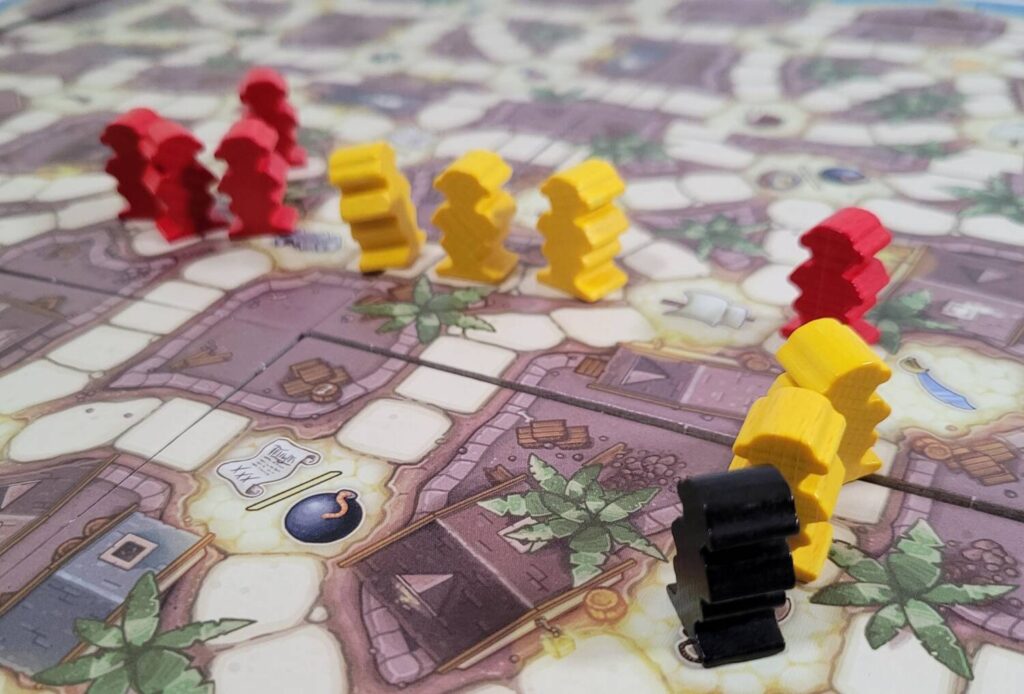
The actions you can perform are sailing, fighting opponents, capturing outposts, occupying control towers, capturing goods at trading posts, meeting the Old Sea Bear, or taking Sailor’s Yarn cards. Taking a Sailor’s Yarn card is self-explanatory. The others require some elaboration.
The Caribbean board is broken up into a 4×4 grid with each section divided by a series of dotted lines. During setup, these sections are pre-populated with Opponent tiles, Outposts, Control Towers, and Trading Posts. Each Trading Post receives a random good. In addition to this, there is a bag of Conflict tiles and five Conflict dice that will be kept close at hand.
At the start of their turn, a player may sail a number of sections equal to the number of pairs of sailors and sails as they have on their Ship board. Ships can never travel over land and, if they enter a section containing a kraken (a specific type of Opponent tile), they must come to a stop. They’re not required to fight the kraken, but they are required to stop their movement.
Once they’ve ended their movement, if the player so chooses, they may fight an opponent. Fighting an opponent involves determining which weapon type is needed (based on the Opponent tile’s type), placing ammo crates (i.e. potential damage) on the Opponent tile (based on how many pairs of sailors and sails you have), and then drawing Conflict tiles from the bag to determine the results. Some Conflict tiles may cause ammo crates to be removed. Some may result in the Opponent counterattacking, forcing you to defend (by rolling Conflict dice) lest you lose resources. If you manage to land a hit, you will gain a reward. If you manage to defeat the opponent, you gain both the reward and get to collect the tile.
Regardless of the outcome, unless the opponent was defeated, the ammo crates remain, making it easier for the opponent to be defeated in the future.
A similar process is used for occupying control towers. Players consult the Control Tower tile to determine which weapon type is needed to occupy it. Then, for each pair of that weapon type and sailor they have, they may place an ammo crate onto the tile. If there are already someone else’s ammo crates there, the player will have to place a higher amount of ammo crates in order to displace the other player.
To capture an outpost, a player just needs to leave one of their pirate meeples there. There is no way to dislodge another player from an already captured outpost, so it’s first come, first serve. Captured outposts reward the players that capture them in two ways: a free weapon (at the time of capture) as well as a new potential starting location when beginning Phase 2.
Each Trading Post features a weapon type icon with a number. The icon dictates which weapon must be used to capture the good from the trading post, and the number dictates how many pairings of said weapon and sailors the player must have in order to perform the action successfully.
Lastly, if the player ends their movement in the section containing the Old Sea Bear, they may opt to meet up with him. Meeting the Old Sea Bear rewards the player with two rum and a Sailor’s Yarn card as well as an opportunity to spend a doubloon to take one of the equipment shown on the current trade tile for that round. In addition to the rum, pirates, sailors, animals, and various cards I’ve already mentioned, other potential rewards include things such as compasses, agreements, and bombs which can be cashed in at specific times for special rewards. Instead of going into all the details about these rewards here, the rule book can be downloaded from Queen Games’s website.
Once you’ve performed all the actions you care to perform, it’s time for…
The Journey Home
As mentioned earlier, on your journey home, you will have the opportunity to visit two stations—Skull Island and Campfire Island—before settling in at your home port. When a player stops at Skull Island, they have a choice: pay 1/3/5 doubloons to move 1/2/3 goods to their Hideout board.
Each player’s Hideout board is different, but each has a display of numbered goods running along its edge in descending order. Players are trying to match up delivered goods with their printed illustrations, and goods must be delivered in order. If a delivered good does not match the next illustration in line, it is added to the 0 space.
“Why deliver goods if they don’t match?” you may be asking. That is because players only have a limited number of holds on their ships. So, undelivered goods take up valuable cargo space. Also, during end-of-game scoring, players are going to add up the values of the covered number spaces and then multiply this by the total number of delivered goods to determine how many victory points they’ll earn from their Hideout. So, even goods sitting in the 0 spot are potentially earning points.
I already talked about Campfire Island, so I won’t go into any detail about it here. These islands must be visited in order, and it takes one player turn per island. Once players have optionally visited these islands, they arrive at their home port (their ship meeple is placed back onto their Ship board) and a scoring is performed. Players earn points for ammo crates left at outposts, points for control towers which contain their ammo crates, and a Sailor’s Yarn card for each opponent leftover with your ammo crates on them. The first player to arrive at their home port will begin the next round as first player.
Except for the end of round four, after all players have reached their home ports, a cleanup is performed and the game is prepared for the next round. At the end of round four, it’s time for…
End of Game and Scoring
This wouldn’t be a Stefan Feld game if there weren’t points coming at you from every direction. At the end of the game, players will earn points from the following:
– ammo crates on control towers multiplied by the number of control towers with crates on them
– total number of collected opponent tokens multiplied by the number of different kinds collected
– the Hideout board as described previously
– total number of weapons of a single type multiplied by the total number of weapon tokens collected
– sets of sailors and animals
– leftover stuff (collected cards, coins, tokens, etc.)
The player with the most points wins, and there is no tiebreaker.
Thoughts
If you read all of that (or scrolled past it) and thought, “Wow, that’s a lot”, you would be correct. Compared to Rum & Pirates, Nassau is far and away the more complex game of the two. And, before I delve into the next bit, let me preface this by saying, I am a massive Stefan Feld fan. Whenever I see his name on the box, I get very excited, and when I see that one of the SFCC games is going to be reimplementing an older title, I use that as an excuse to get that older title to the table so that I’ll have a few recent plays under my belt. Thus, because I am intimately familiar with Rum & Pirates at this point, it is impossible for me to approach Nassau without subconsciously comparing it to the game that it reimplements.
Nassau feels like, when Feld designed it, he had something to prove. “Yeah, Rum & Pirates is probably my weakest game,” it seems to say, “But I can turn it into something more modern with more meat on the bone.” Then he did it. But, did he really need to? And, having done it, how successful is it?
Nassau is a full-bodied game with a lot of complexities and decision points. But, if you ask me, none of those complexities feel necessary, and none of those decisions is particularly interesting. Most of the decisions you’ll need to make really aren’t decisions at all. There’s always going to be something obvious to do and whether or not you succeed comes down to blind luck, a roll of a die or a random pull from a bag. As such, the only agency you ever really have is in Phase 1, the Nassau City phase. And, if that’s the agency you desire, you might as well just play Rum & Pirates instead.
Rum & Pirates leans into its simplicity, and that’s part of its charm. It’s quick, easy, lighthearted, and it doesn’t take itself too seriously. As a result, despite all appearances and expectations, it winds up being a very enjoyable experience. Nassau is almost its complete opposite. The turns feel ponderous. The pacing is slow. Mechanically, it’s all over the place. Complex for the sake of being complex.
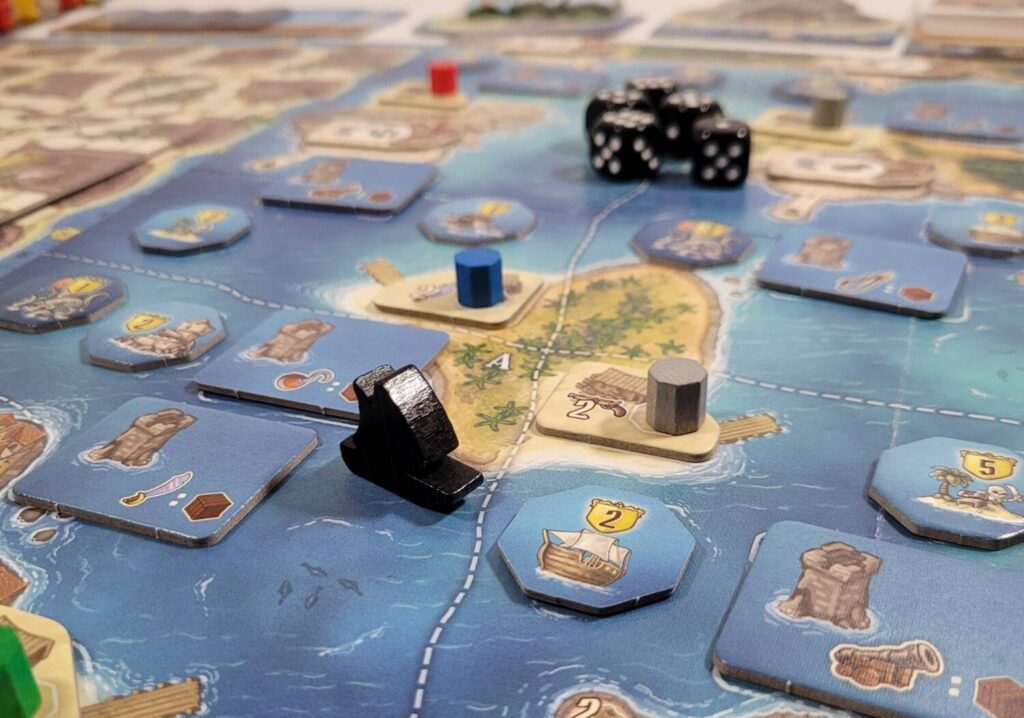
In my opinion, when it comes to the Stefan Feld City collection, Nassau is the weakest of the bunch. I’m not a fan of it. I admit, I may be biased because I am comparing it to Rum & Pirates. Like I said earlier, I can’t help but compare. I don’t dislike the game per se, but I’m not in love with it either. Where Hamburg and Amsterdam left me confidently stating that the game they reimplemented would never hit my table again, Nassau is the complete opposite.
I’m glad Nassau is in my collection, but I doubt it will ever leave my shelf again.




